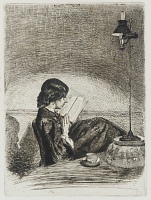Etchings Institutions search term: fitzwilliam museum
Reading by Lamplight | ||
| Number: | 37 | |
| Date: | 1859 | |
| Medium: | etching and drypoint | |
| Size: | 161 x 120 mm | |
| Signed: | 'J. Whistler' at lower right | |
| Inscribed: | no | |
| Set/Publication: | no | |
| No. of States: | 3 | |
| Known impressions: | 40 | |
| Catalogues: | K.32; M.30; T.24; W.25 | |
| Impressions taken from this plate (40) | ||
TECHNIQUE
The original composition was etched, with some details such as the pattern on the bowl in drypoint. In later states there were major alterations and additions in drypoint, as well as some roulette work on the table, the result being softer but slightly uneven shading. Surface tone was used to emphasize the contrasts of light and shade, with the hand and book wiped clean in early impressions. Heavier inking on the shaded areas to some extent compensated for the fading drypoint.
PRINTING
Early impressions of the third state can be fine, with delicate drypoint ( ) or, depending on the inking, very rich, with lovely detail on the dress (
) or, depending on the inking, very rich, with lovely detail on the dress ( ). However, in many impressions the shadows become slightly soft and uneven, and the burr appears irregular, as it wears down, while pitting and foul biting are apparent (
). However, in many impressions the shadows become slightly soft and uneven, and the burr appears irregular, as it wears down, while pitting and foul biting are apparent ( ,
,  ). At times tone was used to enrich the shadows at the top (
). At times tone was used to enrich the shadows at the top ( ,
,  ) and greyer paper was also used to reinforce the atmospheric effect (
) and greyer paper was also used to reinforce the atmospheric effect ( ).
).
 ) or, depending on the inking, very rich, with lovely detail on the dress (
) or, depending on the inking, very rich, with lovely detail on the dress ( ). However, in many impressions the shadows become slightly soft and uneven, and the burr appears irregular, as it wears down, while pitting and foul biting are apparent (
). However, in many impressions the shadows become slightly soft and uneven, and the burr appears irregular, as it wears down, while pitting and foul biting are apparent ( ,
,  ). At times tone was used to enrich the shadows at the top (
). At times tone was used to enrich the shadows at the top ( ,
,  ) and greyer paper was also used to reinforce the atmospheric effect (
) and greyer paper was also used to reinforce the atmospheric effect ( ).
).The plate was steel-faced, and some impressions may have been printed either in the 1890s or after Whistler's death.
